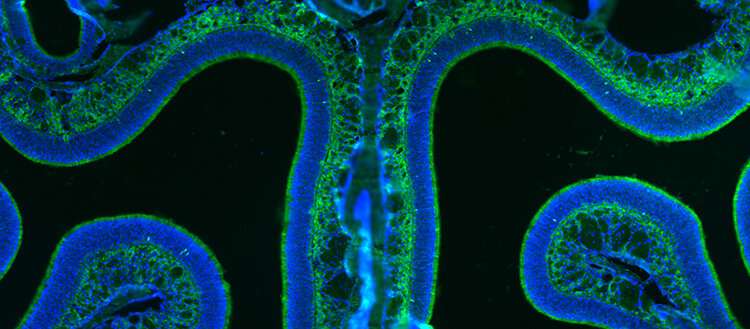Olfactory neurons adapt to the surrounding environment


Olfactory receptors, present on the surface of sensory neurons in the nasal cavity, recognize odorant molecules and relay this information to the brain. How do these neurons manage to detect a large variability of signals and adapt to different levels of stimulation? A joint team from the Faculty of Science and the Faculty of Medicine of the University of Geneva (UNIGE) investigated the gene expression profile of these neurons in the presence or absence of odorant stimulation. The scientists discovered an unsuspected variability in these profiles depending on the expressed olfactory receptor and previous exposure to odors. These results, to be read in the journal Nature Communications, highlight a wide range of identities of olfactory neurons, and their adaptation to the surrounding environment.
In mammals, the perception of odors is ensured by millions of olfactory neurons, located in the mucosa of the nasal cavity. These neurons have on their surface receptors able to bind specifically to an odorant molecule. Each olfactory neuron expresses only one gene coding for an olfactory receptor, chosen from a repertoire of about 450 in humans and 1,200 in mice.
When a volatile molecule is recognized by a receptor, it is activated and generates a signal that is transmitted to the olfactory bulb in the brain, a signal that is then translated into an odor. The olfactory system responds to highly variable environments and must be able to adapt very quickly. For example, during a continuous stimulation by certain odorant molecules, the perceived intensity decreases progressively and sometimes disappears.
The group of Professor Ivan Rodriguez from the Department of Genetics and Evolution of the Faculty of Science, in collaboration with Professor Alan Carleton from the Department of Basic Neurosciences of the Faculty of Medicine, is interested in the adaptive mechanisms of neurons, and in particular of olfactory neurons in mice. In a previous study, the scientists found that after stimulation of a receptor by an odorant molecule for less than an hour, the expression of the gene coding for this receptor decreased in the neuron, indicating a very rapid adaptation mechanism.
Neurons with a specific profile
The biologists continued this approach and explored the possibility that this adaptation to an olfactory experience does not only affect the gene coding for the receptor, but also other genes. To do this, the profile of genes expressed before and after olfactory stimulation was determined in thousands of olfactory neurons by sequencing their messenger RNAs (the molecules that subsequently allow the production of proteins).
“To our surprise, we found that at rest, meaning in an environment without stimulation, the profiles of the messenger RNAs of the populations of olfactory sensory neurons of the mouse are already very different from each other, and are specific to the olfactory receptor they express,” reports Luis Flores Horgue, a doctoral student in the Department of Genetics and Evolution and co-first author of the study. Neurons expressing the same receptor do not only share this receptor but also differ in the expression of hundreds of other genes. Genes whose expression level seems to be directed by the expressed olfactory receptor, which would thus play a double role.
One molecule changes the expression of hundreds of genes
The biologists then analyzed the expression of genes in these neurons after stimulation by odorant molecules. They observed that these molecules induce massive changes in the expression of genes in the activated neurons. “While it was thought that the binding of an odorant molecule would only lead to the activation of the corresponding receptor, we discover that olfactory neurons drastically change their identity by modulating the expression of hundreds of genes after activation. And this new identity is again dependent on the expressed receptor. We are facing an unexpected, massive, rapid and reversible adaptation mechanism,” explains Ivan Rodriguez, co-corresponding author of the study.
Source: Read Full Article